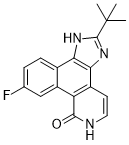Pyridone 6
This product is for research use only, not for human use. We do not sell to patients.

For small sizes, please check our retail website as below: www.invivochem.com
| Size | Price | Stock |
|---|---|---|
| 250mg | $1250 | Check With Us |
| 500mg | $1750 | Check With Us |
| 1g | $2625 | Check With Us |
Cat #: V2962 CAS #: 457081-03-7 Purity ≥ 98%
Description: Pyridone 6 (also known as P6, CMP 6 or JAK Inhibitor I) is a pan-JAK (Janus-activated kinase) inhibitor with potential anti-AD and anticancer activity.
Top Publications Citing Invivochem Products
Publications Citing InvivoChem Products
Product Promise

- Physicochemical and Storage Information
- Protocol
- Related Biological Data
- Stock Solution Preparation
- Quality Control Documentation
| Molecular Weight (MW) | 309.34 |
|---|---|
| Molecular Formula | C18H16FN3O |
| CAS No. | 457081-03-7 |
| Storage | -20℃ for 3 years in powder formr |
| -80℃ for 2 years in solvent | |
| Solubility In Vitro | DMSO: ≥ 31.25 mg/mLr |
| Water: <1 mg/mLr | |
| Ethanol: <1 mg/mL | |
| SMILES Code | O=C1NC=CC2=C1C3=CC(F)=CC=C3C4=C2N=C(C(C)(C)C)N4 |
| Synonyms | P6; P-6; P 6; Pyridone 6; Pyridone-6; Pyridone6; CMP 6; JAK Inhibitor I; Janus-Associated Kinase Inhibitor I |
| Protocol | In Vitro | Pyridone 6 is tested as an inhibitor of 21 other protein kinases; Pyridone 6 inhibits these kinases with IC50s ranging from 130 nM to >10 μM. Pyridone 6 inhibits IL2 driven proliferation of CTLL cells with IC50=0.1 μM and IL4 driven proliferation with IC50=0.052 μM. |
|---|---|---|
| In Vivo | Pyridone 6 (P6) delays the onset and reduced the magnitude of skin disease in an AD-like skin-disease model of NC/Nga mice. P6-nano strongly ameliorates atopic dermatitis (AD) in NC/Nga mice, exerting an effect comparable to that of betamethasone ointment, a commonly used drug, which also tested as a positive control. In contrast, empty polylactic acid with glycolic acid (PLGA) nanoparticles (C-nano) seemed to have no effect. |
These protocols are for reference only. InvivoChem does not
independently validate these methods.
| Solvent volume to be added | Mass (the weight of a compound) | |||
|---|---|---|---|---|
| Mother liquor concentration | 1mg | 5mg | 10mg | 20mg |
| 1mM | 3.2327 mL | 16.1634 mL | 32.3269 mL | 64.6538 mL |
| 5mM | 0.6465 mL | 3.2327 mL | 6.4654 mL | 12.9308 mL |
| 10mM | 0.3233 mL | 1.6163 mL | 3.2327 mL | 6.4654 mL |
| 20mM | 0.1616 mL | 0.8082 mL | 1.6163 mL | 3.2327 mL |
The molarity calculator equation
Mass(g) = Concentration(mol/L) × Volume(L) × Molecular Weight(g/mol)
Mass
=
Concentration
×
Volume
×
Molecular Weight*
The dilution calculator equation
Concentration(start)
×
Volume(start)
=
Concentration(final)
×
Volume(final)
This equation is commonly abbreviated as: C1 V1 = C2 V2
Concentration(start)
C1
×
Volume(start)
V1
=
Concentration(final)
C2
×
Volume(final)
V2
Step One: Enter information below
Dosage mg/kg
Average weight of animals g
Dosing volume per animal µL
Number of animals
Step Two: Enter the in vivo formulation
%DMSO
+
%
+
%Tween 80
+
%ddH2O
Calculation Results:
Working concentration:
mg/ml;
Method for preparing DMSO master liquid:
mg
drug pre-dissolved in
µL
DMSO(Master liquid concentration
mg/mL)
,Please contact us first if the concentration exceeds the DMSO solubility of the batch of drug.
Method for preparing in vivo formulation:
Take
µL
DMSO master liquid, next add
µL
PEG300, mix and clarify, next add
µL
Tween 80,mix and clarify, next add
µL
ddH2O,mix and clarify.
Note:
- (1) Please be sure that the solution is clear before the addition of next solvent. Dissolution methods like vortex, ultrasound or warming and heat may be used to aid dissolving.
- (2) Be sure to add the solvent(s) in order.




































